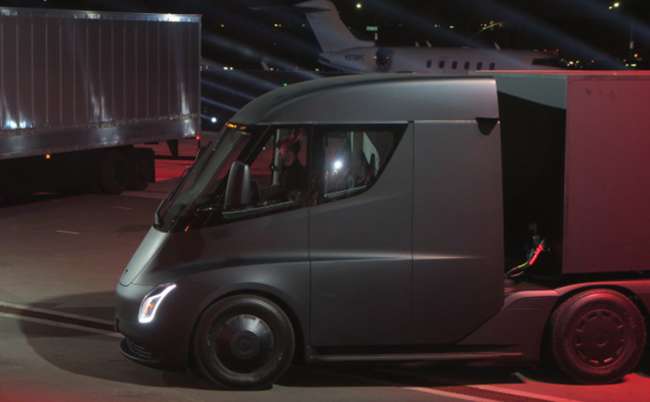Managing Editor, Features and Multimedia
Can Tesla Make Electric Work for Trucking?

HAWTHORNE, Calif. — Tesla’s success in the passenger-car arena has changed consumers’ perceptions and pushed the limits of what’s possible with electric cars.
Can the company’s new all-electric tractor do the same for the commercial truck market?
SPLASHY DEBUT: Tesla Semi's unveiling was a spectacle in itself
FLEETS LINE UP: Some fleets are making reservations to purchase
LIVEONWEB: How does electric fit in with the trucks of tomorrow?
In a splashy unveiling here Nov. 16, Tesla co-founder and CEO Elon Musk revealed his company’s vision of electric-powered trucking with the Tesla Semi, which is set to enter production in 2019.
A few days earlier, Musk proclaimed on Twitter that the truck’s unveiling would “blow your mind clear out of your skull and into an alternate dimension.”
Although the skulls of those in attendance remained intact, the excitement was palpable as Musk introduced a zero-emissions truck suitable not only for shorthaul and port drayage, but also regional operation with a maximum range of 500 miles on a full charge.
Musk said Tesla will build a network of “Megachargers” across the country that eventually will allow its electric trucks to travel anywhere. But as with any infrastructure initiative, that will take time. Early customers likely will need to rely solely on chargers they install at their own terminals.
While buyers of Tesla’s luxury electric cars are willing to pay more for something that is fun and cool, trucking companies make their purchasing decisions based on a more sober assessment of the business case. For fleets to invest in electric vehicles, they will need to see a payback in total cost of ownership.
That reality was not lost on Musk.
In addition to fuel savings, the Tesla Semi will reduce maintenance costs and vehicle downtime because it does away with the internal combustion engine, transmission and aftertreatment equipment, he said. Musk even guaranteed that the truck’s electric powertrain will not break down for a million miles.
However, Tesla has not disclosed how much the vehicle will cost or how much it will weigh. The truck’s battery pack could take a significant bite out of its maximum payload, an important factor for fleets to consider.

The Tesla Semi's radically different interior may appeal to younger operators and may pull more into a trucking workforce that is desperately short of drivers. (Tesla)
Driver acceptance also will be essential, and that’s where the Tesla Semi’s radically redesigned cab could make a big difference.
The driver’s seat in the Tesla Semi is situated in the center of the cab rather than offset to the left, and the steering wheel is flanked by large touchscreens that display all driver information in lieu of a dashboard. Sitting in that seat, a truck driver might feel like he or she is piloting a spaceship rather than a big rig.
One can imagine some longtime truck drivers balking at the vehicle’s interior, but it will likely appeal to younger drivers the industry so desperately needs to attract as it faces an aging workforce and a shortage of qualified drivers. Could the opportunity to sit behind the wheel of one of these trucks entice 20-somethings to take a look at trucking as a potential career path? Quite possibly.
While Musk captured the industry’s attention with his truck unveiling, Tesla is far from alone in the push to make electric vehicles feasible for commercial transportation. Startup Nikola Motor Co. is preparing to launch a Class 8 hydrogen-electric truck designed for longhaul operation. Established truck manufacturers such as Daimler Trucks and Navistar Inc. also are jumping into electric power, as is Cummins Inc., the industry’s largest supplier of diesel engines.
Given this broad level of investment in electric power, it now seems clear that the real question is not if, but when, significant portions of the trucking industry will begin moving toward electric vehicles.
To be clear, diesel still appears to have a long run ahead of it as trucking’s primary fuel, but we may be witnessing the emergence of its eventual successor.




